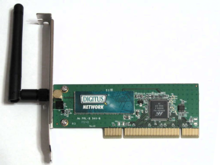A wireless LAN (WLAN) is a wireless computer network that links two or more devices using wireless communication to form a local area network (LAN) within a limited area such as a home, school, computer laboratory, campus, or office building. This gives users the ability to move around within the area and remain connected to the network. Through a gateway, a WLAN can also provide a connection to the wider Internet.
Wireless LANs based on the IEEE 802.11 standards are the most widely used computer networks in the world. These are commonly called Wi-Fi, which is a trademark belonging to the Wi-Fi Alliance. They are used for home and small office networks that link together laptop computers, printers, smartphones, Web TVs and gaming devices with a wireless router, which links them to the internet. Hotspots provided by routers at restaurants, coffee shops, hotels, libraries, and airports allow consumers to access the internet with portable wireless devices.
History[edit]
Norman Abramson, a professor at the University of Hawaii, developed the world's first wireless computer communication network, ALOHAnet. The system became operational in 1971 and included seven computers deployed over four islands to communicate with the central computer on the Oahu island without using phone lines.[1]
Wireless LAN hardware initially cost so much that it was only used as an alternative to cabled LAN in places where cabling was difficult or impossible. Early development included industry-specific solutions and proprietary protocols, but at the end of the 1990s these were replaced by technical standards, primarily the various versions of IEEE 802.11 (in products using the Wi-Fi brand name).
Beginning in 1991, a European alternative known as HiperLAN/1 was pursued by the European Telecommunications Standards Institute (ETSI) with a first version approved in 1996. This was followed by a HiperLAN/2 functional specification with ATM influences[citation needed] accomplished February 2000. Neither European standard achieved the commercial success of 802.11, although much of the work on HiperLAN/2 has survived in the physical specification (PHY) for IEEE 802.11a, which is nearly identical to the PHY of HiperLAN/2.
In 2009 802.11n was added to 802.11. It operates in both the 2.4 GHz and 5 GHz bands at a maximum data transfer rate of 600 Mbit/s. Most newer routers are dual-band and able to utilize both wireless bands. This allows data communications to avoid the crowded 2.4 GHz band, which is also shared with Bluetooth devices and microwave ovens. The 5 GHz band also has more channels than the 2.4 GHz band, permitting a greater number of devices to share the space. Not all WLAN channels are available in all regions.
A HomeRF group formed in 1997 to promote a technology aimed at residential use, but it disbanded in January 2003.[2]
Architecture[edit]
Stations[edit]
All components that can connect into a wireless medium in a network are referred to as stations. All stations are equipped with wireless network interface controllers. Wireless stations fall into two categories: wireless access points (WAPs) and clients. WAPs are base stations for the wireless network. They transmit and receive radio frequencies for wireless-enabled devices to communicate with. Wireless clients can be mobile devices such as laptops, personal digital assistants, VoIP phones and other smartphones, or non-portable devices such as desktop computers, printers, and workstations that are equipped with a wireless network interface.
Service set[edit]
The basic service set (BSS) is a set of all stations that can communicate with each other at PHY layer. Every BSS has an identification (ID) called the BSSID, which is the MAC address of the access point servicing the BSS.
There are two types of BSS: Independent BSS (also referred to as IBSS), and infrastructure BSS. An independent BSS (IBSS) is an ad hoc network that contains no access points, which means they cannot connect to any other basic service set. In an IBSS the STAs are configured in ad hoc (peer-to-peer) mode.
An extended service set (ESS) is a set of connected BSSs. Access points in an ESS are connected by a distribution system. Each ESS has an ID called the SSID which is a 32-byte (maximum) character string.
A distribution system (DS) connects access points in an extended service set. The concept of a DS can be used to increase network coverage through roaming between cells. DS can be wired or wireless. Current wireless distribution systems are mostly based on WDS or Mesh protocols,[3] though other systems are in use.
You received this message because you are subscribed to the Google Groups "1TopReadys1" group.
To unsubscribe from this group and stop receiving emails from it, send an email to 1topreadys1+unsubscribe@googlegroups.com.
To view this discussion on the web visit https://groups.google.com/d/msgid/1topreadys1/CAForgrSgT9YD6NETicB6rzLtZDytFgoMyCibLLf9Ou-9cpvaXg%40mail.gmail.com.

No comments:
Post a Comment